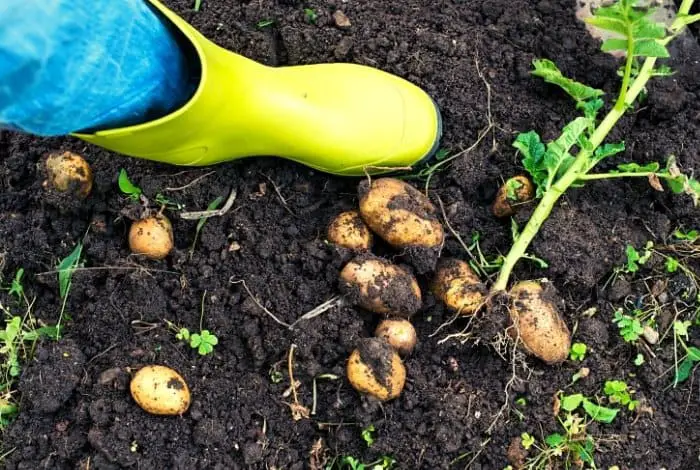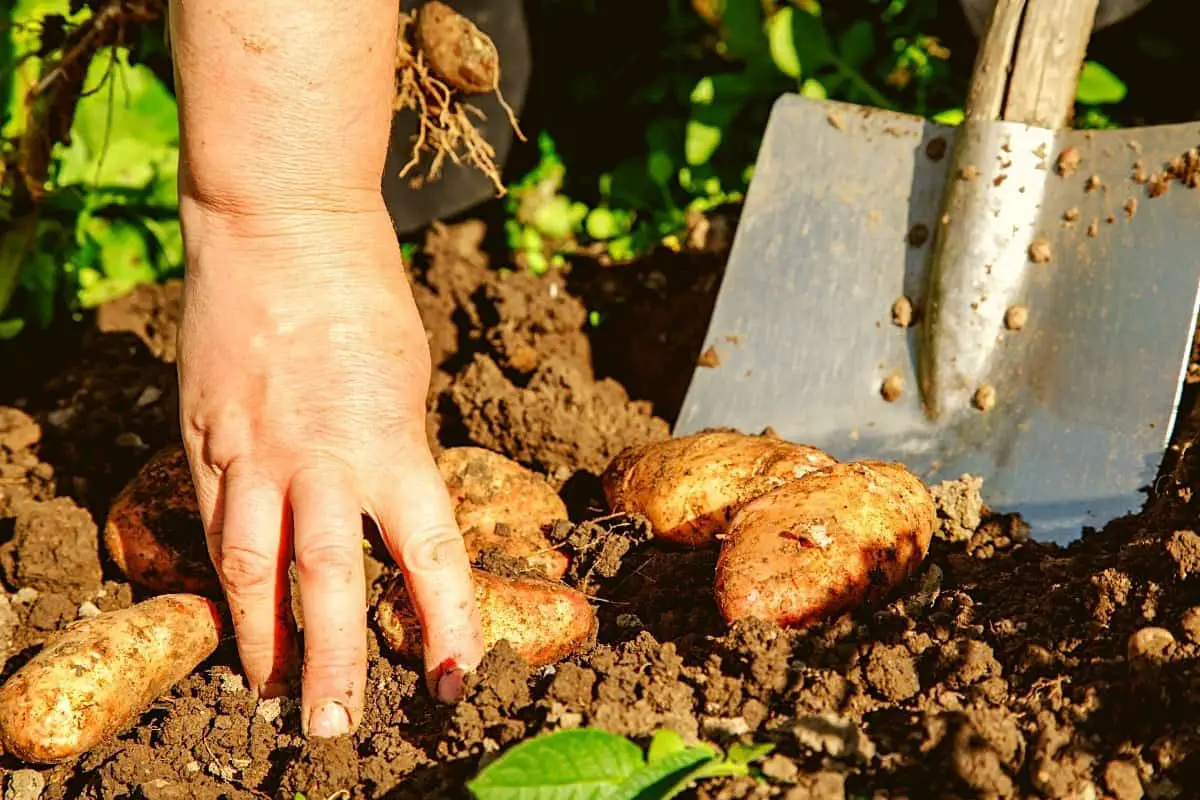Last Updated on June 21, 2023 by Tony Manhart
Knowing when to dig up potatoes and how to store them after harvesting helps gardeners get the best out of their farms with plenty of harvests.
You have planted your potatoes, hilled properly, and fertilized them; now your potatoes are full and healthy ready for harvest time.
You might be wondering when to dig up your potatoes and how to know they are fully mature. We will enlighten you in this article so follow us as we unravel the mystery together.
How To Tell It’s Time To Dig Up Potatoes?
Potatoes are harvested according to the season they were planted and how the owner wants to eat them. Some harvest them as new, old, or matured.
To tell that your regular potatoes are ready for harvesting, look out for several signs:
For regular potatoes check to see if the foliage has withered and died back before you start the harvesting process
With the foliage dead, dig up a potato from a few plants and rub the skin of the potato with your fingers to test if it scrubs off easily. The skin should be firm and not come off easily

New potatoes can be harvested early. These are potatoes that are purposefully harvested early for their tender skin and smaller size. You can harvest them 2 to 3 weeks after the potato plants stop flowering. These new potatoes should not be cured because their skin is not strong enough to last long.
You can now go ahead and harvest your potatoes. Gardeners frequently underestimate the potato and don’t realize its simplistic nature hides not only a world of flavors but also one of the differences and complex growth patterns.
Check out The List of Determinate and Indeterminate Potatoes.
When To Dig Up Potato
The best time to harvest potatoes is in the fall or early winter but it depends on when planting took place. Potatoes tolerate light frost but when hard frost is expected, it’s time to dig them out. In areas that have cool fall without frost, the soil temperature will dictate when you can dig up your potatoes. The soil needs to be above 45 degrees F.
Now that you know the potatoes are mature and ready for harvest, it’s your choice to either harvest all of them or part of them. As you dig your potatoes, be careful not to scrape, cut or bruise the potatoes. Damaged potatoes should not be stored but rather be used up as soon as possible. If you would like to store your potatoes for long-term use, go ahead and allow them to harden a bit. You do this by leaving them in the ground for up to a month after the tops have completely died back.
During the hardening process, keep the potatoes dry with no watering. If it begins to rain or the weather turns out more wet than expected, it’s a good idea to dig the potatoes out. You will not be able to harden off the potatoes with these conditions. But you can safely harvest and bring your potatoes indoors.
After digging your potatoes, do not leave them under the sun for long, otherwise, they will turn green. Green potatoes have a bitter taste and if eaten can cause diarrhea and vomiting. Small green spots can be trimmed off but significant greening must be thrown away.
Storing The Dug-Up Potatoes
Now that you have your potatoes harvested, brush off excess dirt before storing them indoors. Once done store them in a cool dark and dry place away from direct light. If your potato harvest will not last for long, you can store them anywhere. Storage will not be an issue for you. But if the harvest is abundant, store them in a proper place. You can also store them in the fridge for up to 2 months, stored in a plastic zip bag, or well wrapped in plastic to keep them firm and fresh.
If you choose to wash your potatoes before storing them in the refrigerator, be sure to dry them well to prevent rotting. If you have hardened your potatoes before harvesting them and plan to store them over the winter, do not wash them. Brush off the excess soil and store them in a dark dry area. The dirty spuds will dry indoors but leaving them under the sun will be damaging them. Keep your potatoes dry to avoid rot!
Granrosi Wall Mounted Wire Baskets Set of 3 For Potato And Onion Storage
How Deep To Dig For Potatoes?
If you are wondering how deep to dig for potatoes after they have grown, then there are a few things that you should take into consideration. These include the depth you’ve planted them and whether or not they are growing in normal or raised beds. Keep in mind that you must plant them at the right depth so that they will be able to sprout without any hassle, making harvesting much easier.
Digging six to eight inches deep for planting and harvesting is about the depth you should go for potatoes. This will avoid them from rotting before the harvest and sid them from growing their best over time. It is also essential that you space them out as overcrowding will also make it difficult to dig them out properly. Potato roots and tubers need enough space to reach their full potential before harvesting.
When Can I Grow Potatoes?
If you’ve asked yourself, when can I grow potatoes, then take heed of the following information? To begin with, growing potatoes requires certain environmental and climate conditions to keep them thriving. So depending on the USDA plant hardiness zone that your area falls under, the right times may vary. However, when looking at the majority of states in the US, it is evident that March, April, and May are considered the best times to grow potatoes.
After planting during this time, you can expect an abundant harvest in about four months if the potatoes are afforded the proper growing conditions. Additionally, if you live in an area that experiences mild winters then growing potatoes during this time would be quite fine. Many people also have great success growing these vegetables during the fall season in certain states.
All in all, you should consider that potatoes grow in the ground and need moderate weather conditions to thrive, so they will not tolerate freezing conditions. So, planting them when the temperature is super low is not advised as your efforts may be wasted.
How Do You Harvest Bucket Potatoes?
So, how do you harvest bucket potatoes? Just like potatoes grown in the ground in normal or raised beds, bucket-grown ones can be harvested similarly. However, there are key telltale signs to look for before you dig up your potatoes. These include yellowing exposed tops that have wilted and died back. This is the first sign that should alert you that your potatoes are ready to be harvested. Others wait until the first fall frost to dig up their bucket potatoes.
But, the most recommended way to harvest bucket potatoes would be to topple them over onto a spread-out tarp. This makes it much easier to sift through the soil and retrieve the abundant tubers. If you have planted them in a five-gallon bucket, then you can expect to harvest a few pounds of potatoes. If you are looking forward to a much larger yield, then using a larger container or a few five-gallon buckets will prove fruitful.
Keep in mind that if you don’t wait for the tops to die down before picking bucket potatoes, you could be left disappointed with a minuscule yield that is undersized. This may also flaw any replanting plans that you have as early harvesting leads to stressed roots that may not survive another growing season. Digging them up too late on the other hand may also have detrimental results as your potato plants can crack, get damaged during the frost, or ultimately rot.
Harvesting Potatoes
Potatoes are one of America’s favorite vegetables. Each year, every American person consumes about 125 pounds of potatoes. Potatoes are naturally healthy, they are fat-free and cholesterol-free. They are also an excellent source of Vitamin C and a good source of potassium.
Potatoes are a staple food for Americans, and most gardeners love to grow their own. Knowing how to grow, and harvest your own is important to give you plenty to enjoy throughout winter. What are you waiting for, go ahead and grow your own!
Video – How To Sprout Potatoes Before Planting Them
Learn How To Sprout Potatoes Before Planting Them in the following video:
FAQs
What month do you dig up potatoes?
The first thing to know about potatoes is that there are many different varieties. The two most common kinds of potatoes are russets and Yukon Golds. Potatoes should be harvested in the early spring (late February or March) before the soil temperature rises above 55 degrees F. If you can't get your hands on fresh potatoes, then frozen ones will do.
Can you dig potatoes before they have flowered?
Yes, it's possible. There are a number of reasons for this. Potatoes are biennial, meaning that they flower the second year they are planted and produce tubers the first year they bloom.
This means that they are not only a great crop to grow for the soil improvement process, but also for the food production.
How long do you leave potatoes in the ground?
In my opinion, there is no real answer. I've been leaving them out for a week or two at a time and they always seem to have a good root system. I've also seen some potatoes that were planted back in March or April that are still producing well over a year later.
What happens if you harvest potatoes too early?
If you harvest your potatoes when they are still small, they will be very light, and often quite green.
Caroline is a gardener who loves to get down to the nitty–gritty of gardening. She proudly proclaims herself as a ‘dirt worshipper‘ and can often be found deep in the garden, covered in soil and singing to her plants. As a self–proclaimed ‘plant whisperer‘, Caroline believes that plants need love and attention just like any other living thing, and she loves to give them both. When she‘s not tending to her garden, you can often find her researching the latest gardening trends, or teaching others how to make their gardens thrive



